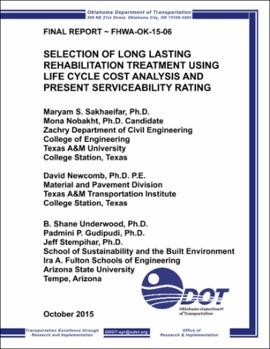| dc.creator | Sakhaeifar, Maryam S. | |
| dc.creator | Newcomb, David | |
| dc.creator | Nobakht, Mona | |
| dc.creator | Underwood, Shane | |
| dc.creator | Gudipudi, Padmini P. | |
| dc.creator | Stempihar, Jeff | |
| dc.date.accessioned | 2018-01-24T17:07:54Z | |
| dc.date.available | 2018-01-24T17:07:54Z | |
| dc.date.issued | 2015-10 | |
| dc.identifier.govdoc | FHWA-OK-15-06 | |
| dc.identifier.other | Oklahoma Department of Transportation State Planning and Research item number 2261 | |
| dc.identifier.uri | https://hdl.handle.net/11244/54315 | |
| dc.description.abstract | A wide range of variables influence the selection strategy for rehabilitation and maintenance of pavements. The focus of this study is to conduct a project-level evaluation of high traffic volume asphalt-surfaced pavements located in the state of Oklahoma and develop a performance based rehabilitation strategy. In order to develop feasible rehabilitation strategies, a systematic collection of relevant pavement-related data was provided by ODOT. The collected data includes performance measurements, traffic, climate and structural integrity of existing pavements obtained by falling weight deflectometer (FWD) analysis. These various data sets are supplemented with laboratory testing to determine the material characterization and damage characterization of different surface rehabilitation mixtures. The national highways located in the state of Oklahoma are divided in several pavement family groups. The representative pavement sections for family groups are identified and the required data for analysis are either extracted from existing sources or measured in the laboratory. Three levels of rehabilitation activities including light, medium and heavy rehabilitation are considered for each of the pavement family groups and a mechanistic-empirical methodology is employed to obtain an estimate of the performance of potential rehabilitation activities and their extended service life. A combination of local material properties, structural integrity and environmental condition are used for structural analysis and development of an evaluation output matrix. At the end of this study a series of time-based renewal solutions are recommended for pavement family groups with a similar existing condition and the most cost effective methodology is determined by performing life cycle cost analysis using RealCost software. | |
| dc.format.extent | 264 pages | |
| dc.format.extent | 13,686,450 bytes | |
| dc.format.medium | application.pdf | |
| dc.language | en_US | |
| dc.relation.ispartofseries | No | |
| dc.relation.requires | Adobe Acrobat Reader | |
| dc.relation.uri | http://www.okladot.state.ok.us/Research/FinalRep_2261_FHWA-OK-15-06.pdf | |
| dc.title | SELECTION OF LONG LASTING REHABILITATION TREATMENT USING LIFE CYCLE COST ANALYSIS AND PRESENT SERVICEABILITY RATING | |
| dc.type | Technical Report | |
| dc.description.version | Final report, November 2013-October 2015 | |
| dc.description.peerreview | No | |
| dc.type.material | text | |
| dc.subject.keywords | Rehabilitation strategy | |
| dc.subject.keywords | mechanistic-empirical analysis | |
| dc.subject.keywords | pavement performance | |
| dc.subject.keywords | life cycle cost analysis | |
| dc.contributor.sponsor | Oklahoma Department of Transportation. Materials and Research Division. Office of Research & Implementation | |
